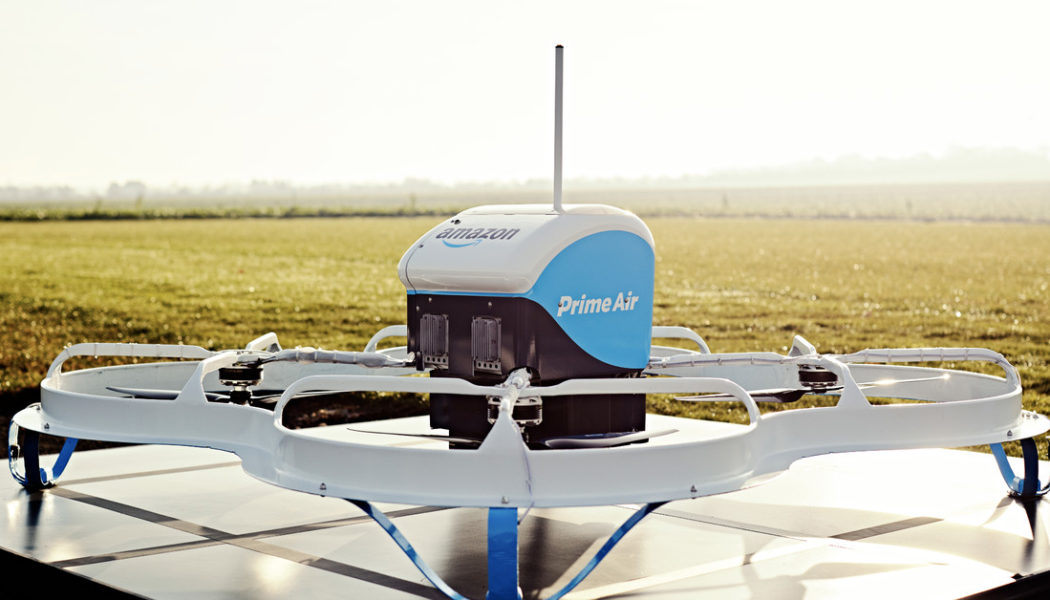
A report from Bloomberg details the obstacles hampering Amazon’s efforts to get its delivery drone program off the ground, citing a high employee turnover rate and potential safety risks.
According to Bloomberg, there were five crashes over the course of a four-month period at the company’s testing site in Pendleton, Oregon. A crash in May took place after a drone lost its propeller, but Bloomberg says Amazon cleaned up the wreckage before the Federal Aviation Administration could investigate.
The following month, a drone’s motor shut off as it switched from an upward flight path to flying straight ahead. Two safety features — one that’s supposed to land the drone in this type of situation and another that stabilizes the drone — both failed. As a result, the drone flipped upside down and made a fiery descent from 160 feet in the air, leading to a brush fire that stretched across 25 acres. It was later put out by the local fire department.
“Instead of a controlled descent to a safe landing, [the drone] dropped about 160 feet in an uncontrolled vertical fall and was consumed by fire,” the FAA said in a report of the incident obtained by Bloomberg.
Former Amazon CEO Jeff Bezos first announced 30-minute drone deliveries in 2013, and almost 10 years later, we still don’t have drones delivering Amazon packages to our doorsteps. In 2019, the company previewed a redesign of its Prime Air delivery drone that has the ability to fly vertically and hinted at launching drone deliveries later that year — a promise that went unfulfilled. One year later, Amazon announced FAA approval for the company to operate as a drone airline in 2020, which Amazon’s vice president of Prime Air said was “an important step forward for Prime Air.”
Last year, a Wired report revealed that Amazon’s drone delivery operation is struggling just as much in the UK, despite making its first-ever drone delivery near Cambridge in 2016. Wired’s report suggests that the UK outfit is marred by some of the same issues described by Bloomberg, including a high turnover rate and potential safety issues. At a UK-based facility for analyzing drone footage for people and animals, one worker reportedly drank beer on the job, while Wired said another held down the “approve” button on their computer regardless of whether there were hazards in the footage or not.
In a statement to The Verge, Amazon spokesperson Av Zammit said the National Transportation Safety Board never classified any of Amazon’s flight tests as an accident, as they didn’t result in any injuries or put structures at risk.
“Safety is our top priority,” Zammit said. “We use a closed, private facility to test our systems up to their limits and beyond. With rigorous testing like this, we expect these types of events to occur, and we apply the learnings from each flight towards improving safety. No one has ever been injured or harmed as a result of these flights, and each test is done in compliance with all applicable regulations.”
Former and current employees at Amazon also told Bloomberg that the company is prioritizing the rushed rollout of its drone program over safety. Cheddi Skeete, a former drone project manager at Amazon, said he was fired last month for speaking with his manager about his safety concerns. Skeete told Bloomberg that he was reluctant to continue testing a drone that had crashed five days previously but was told the team had inspected 180 engines on 30 different drones — Skeete doubted this assertion, as checking the motors is a cumbersome process, Bloomberg reports.
“We take safety reporting seriously — we have a safety reporting system that’s well-known by all our team members, and we encourage them to raise any safety suggestions and concerns,” Zammit told The Verge. “In addition to using this system, we encourage employees to provide any other feedback they may have through their manager, HR, or our leadership team.”
David Johnson, a former drone flight assistant for Amazon, told Bloomberg that Amazon would sometimes perform tests “without a full flight team” and with “inadequate equipment.” Johnson also said the company often assigned multiple roles to one person, a claim Bloomberg says is corroborated by two other former Amazon employees.
“They give people multiple things to do in a very narrow window of time to try to boost their numbers, and people cut corners,” Johnson told Bloomberg. “They were more concerned about pumping flights out and didn’t want to slow down.”









